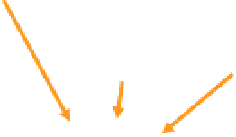Geoscience Reference
In-Depth Information
Atmospheric CO
2
Climate
Ocean acidification
Ocean warming
Seawater
CO
2
Temperature
Mixing,
stratification
Circulation
Atmospheric
deposition
Carbonate
chemistry
Light
Nutrients
Pelagic ecosystems
Rain ratio
(CaCO
3
/POC)
Stoichiometry
(Si/C/N/P/Fe)
C-partitioning
(POC-DOC-TEP)
Nutrient utilization
efficiency
Carbon sinks & sources
Figure 6.1
Schematic representation of the environmental changes affecting pelagic ecosystems and possible feedbacks to the global carbon cycle
(POC, particulate organic carbon; DOC, dissolved organic carbon; TEP, transparent exopolymeric particles).
Table 6.6
Biotic responses to ocean acidii cation and their feedback potential to the global carbon cycle. Responses are characterized
with regard to feedback sign, sensitivity, capacity, and longevity using best guesses (±0 for negligible, + for low, ++ for moderate,
and +++ for high). Empty boxes indicate missing information/understanding (adapted from Riebesell et al. 2009 ).
Process
Sign of feedback
Sensitivity
Capacity
Longevity
+
1
+
1
Calcii cation
Negative
+
Ballast effect
Positive
+++
+++
++
1
?
2
Extracellular organic matter prod.
Negative
+++
++
1
Stoichiometry
Negative
++
++
++
1
?
2
Nitrogen i xation
Negative
+
1
Available information mainly based on short-term perturbation experiments.
2
Potential for adaptation currently unknown.
CO
2
- (and pH)-dependent ecological processes,
which may drive these biogeochemical feedbacks.
In Chapter 12 Gehlen
et al.
use a variety of experi-
mental data and ocean models to explore the poten-
tial magnitude of these feedbacks and their
quantitative impacts on the climate system.
As discussed in the sections above, changes in the
carbonate chemistry of the surface ocean have the
potential to inl uence the physiology and growth of
various members of the pelagic ecosystem, and to
affect the ecological and trophic dynamics which
govern the exchange of energy and cycling of nutri-
ents through the marine food web. For the purposes
of the present discussion, the following changes
will be considered: changes in cellular carbon
processing, changes in phytoplankton species
assemblage composition, and changes in biological
nitrogen cycling.
6.5.1
Changes in cellular carbon processing
Marine pelagic organisms mediate the transforma-
tion of inorganic carbon into organic and inorganic
particulate forms, and into a large dissolved organic
















